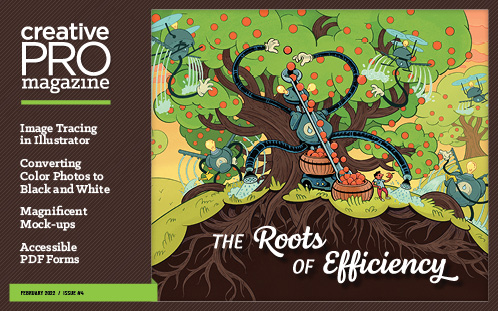The Roots of Efficiency
 This article appeared in Issue 4 of CreativePro Magazine.
This article appeared in Issue 4 of CreativePro Magazine.We all want to get our work done more effectively in less time. And it’s our job to be creative, so we’re always on the alert for anything that will help us mine the richest veins of our imaginations undistracted.
The interwebs are awash with tutorials on how to get the most out of our creative tools. Companies and publishers offer courses, books, and cheat-sheets in which we eagerly invest. Many are valuable, but few warn us about the silent time-thieves that, second by stolen second, add hours to the time it takes to create our best work.
Let’s explore some of them: what they are and how we can eliminate them.
…This article is for members only. To continue reading, please sign in, or sign up for a membership today. Thanks for supporting CreativePro!
BECOME A MEMBER
CreativePro membership keeps you up-to-date with the technology, solutions, and resources to strengthen your professional development.
For just $6.50/month (billed annually), you’ll get access to valuable benefits, including:
- 12 monthly issues of CreativePro Magazine, filled with practical, real-world tutorials written by experts
- Downloadable resources including templates, fonts, scripts, design assets, cheat sheets, and more
- Hundreds of members-only tutorial and tip articles
- Top Tips for InDesign, Photoshop, and Illustrator ebook collection
- Discounts on events and books
- and more...
More Resources To Long Documents
CreativePro Week is the essential HOW-TO conference for creative professionals who design, create, or edit in Adobe InDesign, Photoshop, Illustrator, Acrobat, and Microsoft PowerPoint.
Featuring over 30 expert speakers and 75 sessions and tutorials, CreativePro Week offers five days of in-depth training and inspiration, all in one place. No matter your skill level, you’ll learn techniques and best practices you can start using immediately to improve your productivity.
Members get a special discount on registration! Sign up today.




Fantastic. Love this thinking. I’m just beginning to learn this stuff, and there is so much groundwork to lay, but you make me feel better about my desire to learn and set things up systematically, rather than just ‘dive in and finish a bit faster’ but also ‘reinvent the wheel, forever.’
That’s great, Courtenay. Thank you! The very best of luck with your adventure.
I agree with the previous comment. A very thought-provoking and stimulating article.
谢谢! I’m very happy that you found it useful.
Love, love, love this article! I’ve been trying to teach people at work the importance of naming everything because it does make life easier – for them and for anyone else having to find and then work on the same file. You are so right about habit-forming making more room for creativity. Will be sharing this and breaking it down into chunks to post in our internal newsletter under the tips ‘n’ tricks section. Thank you for sharing your experience.
Fantastic! That’s why I wrote it, so you just made my day.
Great article! Now I know why I do 80% of my work after 10pm. Sometimes I even email people drafts etc at 2am to their shock and surprise. lol Day work for me is just about meetings, quick graphic tasks, and e-mails but the real work is when everyone else is sleeping heh heh. I don’t think I realized how much that was related to me eliminating interruptions before!
We joke that “Cars run on gasoline, designers run on coffee,” but all those daytime interruptions are a big reason it’s so often true. Setting up a schedule to compartment your time (and sticking to it!) is a huge help. Keep meetings out of production time as much as possible. The main thing is to make your creative time sacrosanct and get over the idea that isolating yourself is being rude. Stephen King writes about this in his book “On Writing.” His technique is to lock himself in his writing room with no phone and a big, fat “Do Not Disturb” message to the world at large.
In the last decade or two, our culture has developed a communication neurosis: the idea that every conversation must be in real time; emails and texts must be answered NOW. It’s a recipe for stress. Emails, contrary to popular anxiety, will happily sit there until your next scheduled “email time.” Texts do not have to be answered within seconds of arrival. Your phone has a “Do Not Disturb” feature, or you can just silence it. You must claim title to your own space and time or you run constantly at effect.
Years ago, someone described the pager as “the rudest device in existence,” because it was liable to interrupt anything, anytime. You can 10x that for mobile phones.
Even with all of that, there’s an almost mystical calm that descends when the “normal” world goes to sleep. I know many writers, artists, designers, and other creatives who are at their most productive very early in the morning or very late at night, when the outside world is quiet.